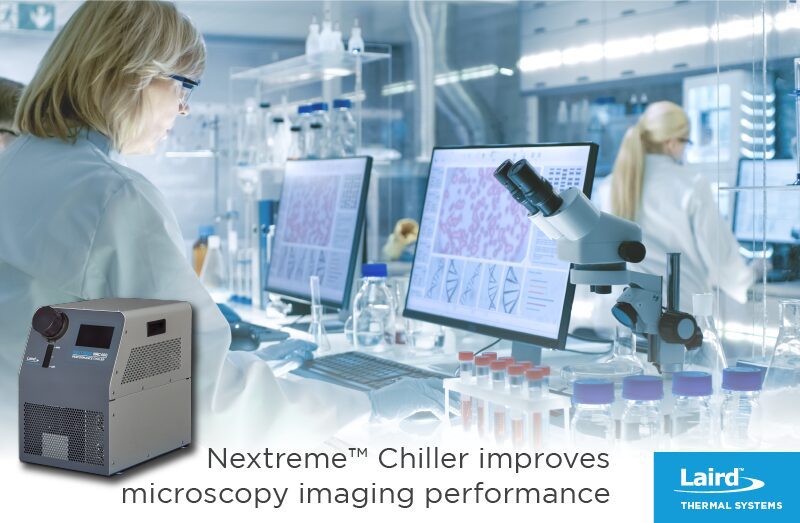The advanced design of Laird Thermal Systems’ new thermoelectric-based Nextreme™ NRC400 Performance Chiller provides a highly reliable cooling solution for digital light microscope applications.
This next-generation recirculating chiller achieves 400 watts of cooling capacity and a temperature control stability to within ±0.05°C under steady-state conditions to ensure high-resolution images and long-life operation with zero global warming potential.
Digital light microscopes utilizing a CCD or CMOS sensor-based camera, such as those used in life science and biotechnology research, require precise temperature control to maintain high-quality image resolution. Digital microscopes contain several imaging sensors and field-programmable gate array (FPGA) semiconductors to enhance image quality and camera functionality. Because CCD and CMOS image resolution degrades as temperature increases, sensor temperatures of 18°C or lower may be required to allow for long exposures.
“It can be difficult to control the temperature in sophisticated analytical imaging instruments. Simple passive thermal solutions such as heat sinks and fans can radiate heat to surrounding electronics and elevate their temperatures,” says Andrew Dereka, Thermoelectrics Product Director at Laird Thermal Systems. “Thermoelectric-based recirculating chillers provide precise temperature control with low pulsation and efficiently route heat away from sensitive electronics, ensuring maximum image resolution.”
To achieve optimal digital microscope operating temperatures, refrigeration systems are required to cool imaging sensors below ambient temperatures. This isn’t possible with passive cooling technologies like liquid heat exchangers that cool slightly above ambient. Sensitive optoelectronic components in cameras need to be temperature controlled to a stability of ±0.05°C or better. Cooling laser optics and sensitive components also maximizes equipment uptime, reduces maintenance, and increases the mean time between failures (MTBF).
The Nextreme NRC400 Performance Chiller is a premium thermoelectric-based chiller utilizing high-performance Peltier coolers and heat exchanger technology. The chiller incorporates a brand-name pump with low pulsation assuring minimal noise to sensitive optoelectronics. Solid-state thermoelectric technology reduces the number of moving parts, minimizing maintenance requirements throughout the life of the product.
Other NRC400 features include an intuitive easy-to-use LCD touchscreen display that allows users to control temperature setpoints and alarm features, and a semi-closed system with a larger reservoir tank, requiring less refilling during operation and better temperature stability. Additionally, unlike traditional compressor-based systems, thermoelectric-based chillers are designed with portability in mind, which means that they can be easily moved around in the laboratory.
This product has been approved by UL for industrial lab use, reference UL 61010-1 and has CE marking. The NRC400 is RoHS-compliant and environmentally friendly as no harmful HFC refrigerants are used, resulting in zero global warming potential. It operates on a universal power supply, making it easy to source one part number for global use.
